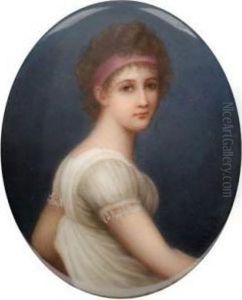Auguste Wilhelmine Amalie Paintings
Auguste Wilhelmine Amalie, Duchess of Leuchtenberg, was not an artist but a notable figure in European nobility during the late 18th and early 19th centuries. Born on June 21, 1780, in Darmstadt, Germany, she was a member of the House of Hesse-Darmstadt, a prominent German noble family. Her life was significantly shaped by the complex political and social landscapes of her time, including the upheavals brought about by the Napoleonic Wars.
Auguste's significance in art history may not come from her own artistic contributions but rather from her role as a patron and her connections within the artistic and cultural circles of her era. Her marriage to Eugène de Beauharnais, the adopted son of Napoleon Bonaparte, in January 1806, elevated her status and influence across Europe. Eugène was appointed the Duke of Leuchtenberg and Prince of Eichstätt, titles that Auguste shared as his consort.
Throughout her life, Auguste was known for her sophisticated taste and her support for the arts. Living through a period that saw the transition from Neoclassicism to Romanticism, she and her husband were significant patrons of the arts. Their courts were centers of cultural activity, attracting artists, writers, and musicians. Though not an artist herself, Auguste's role in the cultural and social spheres of her time underscores the importance of patronage in the development and dissemination of artistic movements and styles.
Auguste Wilhelmine Amalie, Duchess of Leuchtenberg, passed away on May 13, 1848, in Munich, Bavaria. Her legacy is intertwined with the broader historical and cultural narratives of early 19th-century Europe, reflecting the intricate relationships between nobility, politics, and the arts during this transformative period.
